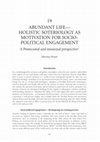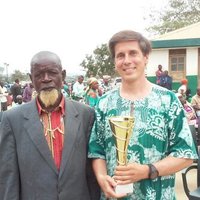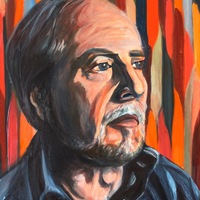Papers by Martina Björkander
Who Got the Rite Wrong? The Mavuno Alternative Christmas Service and Charismatic Ritual, 2024
This is an open access chapter distributed under the terms of the CC BY-NC 4.0 license.

A Rhythm that Connects my Heart with God: Worship, Ritual and Pentecostal Spirituality as Theology, 2021
Doctoral Thesis, Lund University.
This qualitative theological study seeks to shed light on pent... more Doctoral Thesis, Lund University.
This qualitative theological study seeks to shed light on pentecostal theology and spirituality through an investigation of worship as it is practiced in two urban pentecostal-charismatic churches in Nairobi, Kenya. The empirical data serve as a springboard for theological construction and interpretation from a pentecostal perspective. In contemporary charismatic liturgy, the first section of the service consists of communal music-making, led from the pulpit by a band or a choir. Ritually speaking, the section has a specific flow and format, and theologically speaking, it relies on certain kinds of convictions. It is this ritualized communal pentecostal music-making that is the starting point of the examination. In pentecostal idiom, it is known as ‘praise and worship’ or simply ‘worship’.
Theoretically, the study combines insights from pentecostal studies, more specifically pentecostal theology, and ritual studies, particularly performance theory. In the past, pentecostal theologians have often pointed out the close connection between pentecostal spirituality and theology, and how the two cannot be understood apart from each other. Commonly, a tripartite model is used to explain different dimensions of this pentecostal spirituality-as-theology, expressed with the Greek words orthodoxy (right doctrine), orthopraxy (right praxis), and orthopathy (right affections). It is in the interplay between these dimensions that pentecostal spirituality ‘happens’, as it were.
This study modifies and applies this model by looking at worship (in the sense of communal musicking) from three different angles: 1) ritualization and practice (Orthopraxis, Chapter Three); 2) embodiment and affection (Orthopathos,Chapter Four); 3) theologizing and doctrine (Orthopistis,Chapter Five). At the same time, the study underlines the interconnectedness between these dimensions and their relation to larger issues by adding a fourth dimension: 4) transformation and integration (Orthodoxa, Chapter Six). Thus, orthodoxa is a way to speak of worship as including and yet transcending all its component parts, highlighting the richness of the practice and its connection to life as a whole. The argument of this thesis is that it is only when we understand this connection between worship (as practice) and worship (as spirituality) that we start to understand what worship entails from a pentecostal perspective. In doing so, the analysis is indebted to ritual theorists and their understanding of ritual as embodied action, functioning in complex ways to create meaning, attune bodies, and enact transformation. By utilizing a performance perspective on ritual the study highlights the way worship is enacted in time and space. This perspective opens to analysis non-intellectual dimensions of worship—emotional, physical, kinaesthetic and sensual—thereby assigning active rather than passive roles to participants.
The methodological approach is informed by ethnography and uses a combination of methods: participant observation, interviews, surveys and song collection. The study is based on a total of five months of fieldwork in Nairobi, conducted in 2013 and 2014. Two churches were selected as the main focus of research: Mavuno Church, Bellevue, and Christ is the Answer Ministries (CITAM), Woodley, referred to simply as Mavuno and Woodley. In the history of revitalization in urban Kenya, they and their respective mother churches (Nairobi Chapel and Nairobi Pentecostal Church/CITAM) are profiled representatives of the most recent strand of renewal, the Progressive Pentecostal Churches (PPC).
At the heart of Pentecostalism is its spirituality, which finds one of its major expressions in worship; thus, worship may serve as a window into the very heart of Pentecostalism.
Alvarsson, Jan-Åke (red.), Medlemskap. En tvärvetenskaplig studie av medlemskap i Pingströrelsen.... more Alvarsson, Jan-Åke (red.), Medlemskap. En tvärvetenskaplig studie av medlemskap i Pingströrelsen. Uppsala: Forskningsrapporter från Institutet för pentekostala studier.
Book chapter from "Llamados a loas naciones: La misión pentecostal sueca" edited by Andreas Svedm... more Book chapter from "Llamados a loas naciones: La misión pentecostal sueca" edited by Andreas Svedman and Gunnar Swahn, Libris förlag. Spanish translation of "Guds folk - en missionerande gemenskap".
Book chapter in "Called to the nations: Swedish Pentecostal Mission" edited by Andreas Svedman an... more Book chapter in "Called to the nations: Swedish Pentecostal Mission" edited by Andreas Svedman and Gunnar Swahn, Libris förlag. English translation of "Guds folk - en missionerande gemenskap".
Guds folk - en missionerande gemenskap
Book chapter in "Kallade till nationerna: En antologi om svensk pingstmission", edited by Andrea... more Book chapter in "Kallade till nationerna: En antologi om svensk pingstmission", edited by Andreas Svedman and Gunnar Swahn. Swedish original.
This iext is to introduce the research project Worship: a Window into Pentecostal Theology, which... more This iext is to introduce the research project Worship: a Window into Pentecostal Theology, which is a ؟ ualitative study seeking to shed light on Pentecostal theology through an investigation of worship as it is practiced in two urban Pentecostal/€harismatic churches in Nairobi, Kenya. At the heart of Pentecostalism is its spirituality, and this spirituality finds worship as one of its major expressions. Thus worship may serve as a window into the very heart of Pentecostalism.

In a world plagued by terrorism and global catastrophes, when the news media is often filled with... more In a world plagued by terrorism and global catastrophes, when the news media is often filled with reports of wars and human suffering—where does the Christian Church stand? What does it mean to preach salvation in a world of such widespread tragedy? In what way can Christian theology contribute to an increased involvement for justice, peace, and sustainable living? For me, as a Pentecostal theologian, daughter of Swedish Pentecostal missionaries, raised in Rwanda, and deeply affected by the horrors of ethnic cleansing that occurred in the country, the question of salvation and its relation to good and evil, society and justice has become central to my theological thinking. In this chapter, I will propose a holistic model for understanding salvation as “abundant life” (John 10:10) and suggest that such a model would promote our involvement—as Christians and Pentecostals—in societal reform. To reach that conclusion, I will present insights and examples from the Swedish Pentecostal movement, African Pentecostal theology, and Latin American liberation theology from the 1960s. Finally, the argument ends with an effort to portray Jesus, the Savior Himself, the King of Peace, He
who is Life and gives life.
Disclaimer: Due to an editorial mistake, this article contains a faulty rendition of the Swedish word "befrielse" (liberation/deliverance).
Faith in African Lived Christianity, Sep 11, 2019
This is an open access chapter distributed under the terms of the CC-BY-NC-Nd 4.0 License.

Mission Studies
In this article, the theological meaning of transformation is examined from the vantage point of ... more In this article, the theological meaning of transformation is examined from the vantage point of a local Pentecostal church in Nairobi, Kenya, and its liturgical practices. The church under study is the Woodley branch of Christ is the Answer Ministries (CITAM Woodley), formerly Nairobi Pentecostal Church (NPC) Woodley, and data was collected through field research. Arguing with the help of Steven Land’s standard work Pentecostal Spirituality. A Passion for the Kingdom, it is demonstrated that praise and worship rituals function as vehicles for transformation in the theology/spirituality of the informants. Singing and making music are not optional or random activities, but constitute a core ritual providing congregants a viable route to a central goal of Pentecostal spirituality: transformation. Transformation is thus both an idea and a goal, and praise and worship rituals – including the songs sung in worship – constitute a crucial link between the two.
Teologi för hela skapelsen - en studie om teologiska grunder för engagemang i miljö och samhälle
Research report from IPS, the Institute for Pentecostal Studies, Uppsala. In Swedish. Editors; Ma... more Research report from IPS, the Institute for Pentecostal Studies, Uppsala. In Swedish. Editors; Magnus Wahlström and Jan-Åke Alvarsson.
The report deals with issues related to social and environmental action, based on pentecostal theology. My chapter is called "Överflödande liv – holistisk soteriologi som motivation för sociopolitiskt engagemang" and draws on the results of my MA thesis "Abundant life – Soteriology and Socio-Political Involvement in African Pentecostal Theology."
Pentekostal barn-och familjeteologi Rapport från ett forskningsprojekt på IPS 2011-2012 FORSKNINGSRAPPORTER FRÅN INSTITUTET FÖR PENTEKOSTALA STUDIER NR 4
Research report from IPS, the Institute for Pentecostal Studies, Uppsala. In Swedish. Editor: Jan... more Research report from IPS, the Institute for Pentecostal Studies, Uppsala. In Swedish. Editor: Jan-Åke Alvarsson. "Pentecostal child theology," deals with issues related to children from a pentecostal theological perspective.
My chapter in the report, "Barnet och Frälsningen," discusses soteriology and small children; What does Salvation mean when children are considered? It includes such questions as sin, faith, baptism, regeneration, and redemption.
BA thesis, in Swedish. "Spirit, Word and Experience - a study of African Pentecostal Theology"
MA Thesis on the link between Soteriology and Socio-Political Involvement in African Pentecostali... more MA Thesis on the link between Soteriology and Socio-Political Involvement in African Pentecostalism. In dialogue with Liberation theology.










Uploads
Papers by Martina Björkander
This qualitative theological study seeks to shed light on pentecostal theology and spirituality through an investigation of worship as it is practiced in two urban pentecostal-charismatic churches in Nairobi, Kenya. The empirical data serve as a springboard for theological construction and interpretation from a pentecostal perspective. In contemporary charismatic liturgy, the first section of the service consists of communal music-making, led from the pulpit by a band or a choir. Ritually speaking, the section has a specific flow and format, and theologically speaking, it relies on certain kinds of convictions. It is this ritualized communal pentecostal music-making that is the starting point of the examination. In pentecostal idiom, it is known as ‘praise and worship’ or simply ‘worship’.
Theoretically, the study combines insights from pentecostal studies, more specifically pentecostal theology, and ritual studies, particularly performance theory. In the past, pentecostal theologians have often pointed out the close connection between pentecostal spirituality and theology, and how the two cannot be understood apart from each other. Commonly, a tripartite model is used to explain different dimensions of this pentecostal spirituality-as-theology, expressed with the Greek words orthodoxy (right doctrine), orthopraxy (right praxis), and orthopathy (right affections). It is in the interplay between these dimensions that pentecostal spirituality ‘happens’, as it were.
This study modifies and applies this model by looking at worship (in the sense of communal musicking) from three different angles: 1) ritualization and practice (Orthopraxis, Chapter Three); 2) embodiment and affection (Orthopathos,Chapter Four); 3) theologizing and doctrine (Orthopistis,Chapter Five). At the same time, the study underlines the interconnectedness between these dimensions and their relation to larger issues by adding a fourth dimension: 4) transformation and integration (Orthodoxa, Chapter Six). Thus, orthodoxa is a way to speak of worship as including and yet transcending all its component parts, highlighting the richness of the practice and its connection to life as a whole. The argument of this thesis is that it is only when we understand this connection between worship (as practice) and worship (as spirituality) that we start to understand what worship entails from a pentecostal perspective. In doing so, the analysis is indebted to ritual theorists and their understanding of ritual as embodied action, functioning in complex ways to create meaning, attune bodies, and enact transformation. By utilizing a performance perspective on ritual the study highlights the way worship is enacted in time and space. This perspective opens to analysis non-intellectual dimensions of worship—emotional, physical, kinaesthetic and sensual—thereby assigning active rather than passive roles to participants.
The methodological approach is informed by ethnography and uses a combination of methods: participant observation, interviews, surveys and song collection. The study is based on a total of five months of fieldwork in Nairobi, conducted in 2013 and 2014. Two churches were selected as the main focus of research: Mavuno Church, Bellevue, and Christ is the Answer Ministries (CITAM), Woodley, referred to simply as Mavuno and Woodley. In the history of revitalization in urban Kenya, they and their respective mother churches (Nairobi Chapel and Nairobi Pentecostal Church/CITAM) are profiled representatives of the most recent strand of renewal, the Progressive Pentecostal Churches (PPC).
At the heart of Pentecostalism is its spirituality, which finds one of its major expressions in worship; thus, worship may serve as a window into the very heart of Pentecostalism.
who is Life and gives life.
Disclaimer: Due to an editorial mistake, this article contains a faulty rendition of the Swedish word "befrielse" (liberation/deliverance).
The report deals with issues related to social and environmental action, based on pentecostal theology. My chapter is called "Överflödande liv – holistisk soteriologi som motivation för sociopolitiskt engagemang" and draws on the results of my MA thesis "Abundant life – Soteriology and Socio-Political Involvement in African Pentecostal Theology."
My chapter in the report, "Barnet och Frälsningen," discusses soteriology and small children; What does Salvation mean when children are considered? It includes such questions as sin, faith, baptism, regeneration, and redemption.
This qualitative theological study seeks to shed light on pentecostal theology and spirituality through an investigation of worship as it is practiced in two urban pentecostal-charismatic churches in Nairobi, Kenya. The empirical data serve as a springboard for theological construction and interpretation from a pentecostal perspective. In contemporary charismatic liturgy, the first section of the service consists of communal music-making, led from the pulpit by a band or a choir. Ritually speaking, the section has a specific flow and format, and theologically speaking, it relies on certain kinds of convictions. It is this ritualized communal pentecostal music-making that is the starting point of the examination. In pentecostal idiom, it is known as ‘praise and worship’ or simply ‘worship’.
Theoretically, the study combines insights from pentecostal studies, more specifically pentecostal theology, and ritual studies, particularly performance theory. In the past, pentecostal theologians have often pointed out the close connection between pentecostal spirituality and theology, and how the two cannot be understood apart from each other. Commonly, a tripartite model is used to explain different dimensions of this pentecostal spirituality-as-theology, expressed with the Greek words orthodoxy (right doctrine), orthopraxy (right praxis), and orthopathy (right affections). It is in the interplay between these dimensions that pentecostal spirituality ‘happens’, as it were.
This study modifies and applies this model by looking at worship (in the sense of communal musicking) from three different angles: 1) ritualization and practice (Orthopraxis, Chapter Three); 2) embodiment and affection (Orthopathos,Chapter Four); 3) theologizing and doctrine (Orthopistis,Chapter Five). At the same time, the study underlines the interconnectedness between these dimensions and their relation to larger issues by adding a fourth dimension: 4) transformation and integration (Orthodoxa, Chapter Six). Thus, orthodoxa is a way to speak of worship as including and yet transcending all its component parts, highlighting the richness of the practice and its connection to life as a whole. The argument of this thesis is that it is only when we understand this connection between worship (as practice) and worship (as spirituality) that we start to understand what worship entails from a pentecostal perspective. In doing so, the analysis is indebted to ritual theorists and their understanding of ritual as embodied action, functioning in complex ways to create meaning, attune bodies, and enact transformation. By utilizing a performance perspective on ritual the study highlights the way worship is enacted in time and space. This perspective opens to analysis non-intellectual dimensions of worship—emotional, physical, kinaesthetic and sensual—thereby assigning active rather than passive roles to participants.
The methodological approach is informed by ethnography and uses a combination of methods: participant observation, interviews, surveys and song collection. The study is based on a total of five months of fieldwork in Nairobi, conducted in 2013 and 2014. Two churches were selected as the main focus of research: Mavuno Church, Bellevue, and Christ is the Answer Ministries (CITAM), Woodley, referred to simply as Mavuno and Woodley. In the history of revitalization in urban Kenya, they and their respective mother churches (Nairobi Chapel and Nairobi Pentecostal Church/CITAM) are profiled representatives of the most recent strand of renewal, the Progressive Pentecostal Churches (PPC).
At the heart of Pentecostalism is its spirituality, which finds one of its major expressions in worship; thus, worship may serve as a window into the very heart of Pentecostalism.
who is Life and gives life.
Disclaimer: Due to an editorial mistake, this article contains a faulty rendition of the Swedish word "befrielse" (liberation/deliverance).
The report deals with issues related to social and environmental action, based on pentecostal theology. My chapter is called "Överflödande liv – holistisk soteriologi som motivation för sociopolitiskt engagemang" and draws on the results of my MA thesis "Abundant life – Soteriology and Socio-Political Involvement in African Pentecostal Theology."
My chapter in the report, "Barnet och Frälsningen," discusses soteriology and small children; What does Salvation mean when children are considered? It includes such questions as sin, faith, baptism, regeneration, and redemption.
Combining rich theoretical and theological insight with an in-depth case study of worship practices in Nairobi, Kenya, this interdisciplinary study offers a significant contribution to knowledge and is bound to influence scholarly discussions for years to come. The book is a must-read for anyone interested in Pentecostal worship, ritual, and spirituality. https://brill.com/display/title/63398